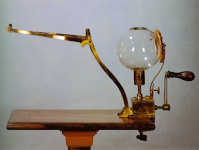
44 x 19.4 x 27
Glass, brass, iron, wood and chamois
INDEX 1788 : Q.III.IV.529
Machina Electrica superiori similis, cujus tamen globus vitreus est magis electricus.
An electrical machine similar to the previous one, but whose glass sphere is more electrical.
The Gabinete de Física in Coimbra used to have three identical electrostatic machines by Edward Nairne, with glass spheres. The three machines were from Colégio dos Nobres. There are now only two, this one and another which differs from it in that, according to the Index, the glass of the sphere is less susceptible to charging. The sphere rotates on its vertical axis, by means of a handle that fits in a metal box. This box has a leaf underneath to hold it to the table. The sphere is charged by friction as the glass rubs against a chamois pad. The Coimbra machines bear the identifying inscription of the maker: "EDWD. NAIRNE Fronting the Royal Exchange LONDON".
The machine is mounted on a stirrup-shaped frame with two small hooks. This stirrup was used to adapt the charge collectors. This system had already been used by Peter van Musschenbroek in one of the electrical models described in his Introductio ad Philosophiam Naturalem.
The Gabinete de Física in Coimbra also used to have an electrical machine, acquired after its establishment, corresponding to Musschenbroek's machine. The following reference to it appears in the Index Instrumentorum: "Machine Electrica prestantissima, in qua globus vitreus circa axes celerrime circumvehitur ope rotae dentatae a triplici cochelea in Orbem acta, et vecte cum manubrio instructa. Machina imponitur stylobatae ligneo affabre eleaborato, quo cum firmatur cochelea. Convenit eadem Machina cum ea, quae describitur a Muschembrockio in sua Introduct. cit. Tom I, § 848. Tab XXII, fig. I". "An outstanding electrical machine in which a glass ball turns very rapidly on its axis with the aid of a toothed wheel; this is activated by means of a triple screw and has a lever with a handle. The machine is screwed to a handsomely carved wooden column. This machine is like that described by Musschenbroek in his already mentioned Introductio, vol. I, § 848, plate XXII, fig. 1". Unfortunately this machine has not survived to the present day.
From Colégio dos Nobres, catalogue n.º 514.Musschenbroek, Peter van, Introductio ad Philosophiam Naturalem, Leiden, 1762, Vol. I, § 848, Tab. XXII, Fig. 1.